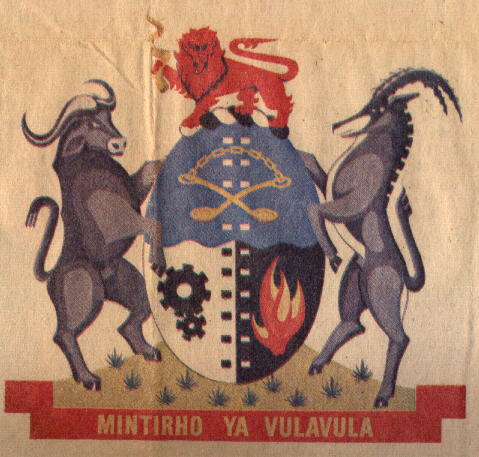Gazankulu: Difference between revisions
Knorrepoes (talk | contribs) No edit summary |
Knorrepoes (talk | contribs) m (Text replace - "[[Literature" to "{{media}} [[Literature") |
||
| Line 23: | Line 23: | ||
The supporters are a buffalo(<I>Syncerus caffer</i>) and a Roan Antelope (<I>Hippotragus equinus</I>). | The supporters are a buffalo(<I>Syncerus caffer</i>) and a Roan Antelope (<I>Hippotragus equinus</I>). | ||
{{media}} | |||
[[Literature]] : The Star 20-06-1975; Brownell, FG: 1998: Symbols of Sovereignty of South Africa's former Independent and Self-Governing National States. | [[Literature]] : The Star 20-06-1975; Brownell, FG: 1998: Symbols of Sovereignty of South Africa's former Independent and Self-Governing National States. | ||
Revision as of 21:50, 8 July 2014
| Heraldry of the World Civic heraldry of South Africa |
GAZANKULU
Incorporated into : 1994 Limpopo, Mpumalanga
Official blazon
Origin/meaning
The arms were officially granted on September 8, 1972.
The shape of the shield is in Nguni-style, one of the local styles.
The spoon and chain links symbolise the peace and hospitality of the people. The wheel are a symbol of industry. The black and white in the lower part symbolises the co-operation between the two peoples. The crest is the symbol of power.
The crest shows the lion, derived from the old South African arms, holding a kudu horn.
The supporters are a buffalo(Syncerus caffer) and a Roan Antelope (Hippotragus equinus).
Contact and Support
Partners:
Your logo here ?
Contact us
© since 1995, Heraldry of the World, Ralf Hartemink 
Index of the site
Literature : The Star 20-06-1975; Brownell, FG: 1998: Symbols of Sovereignty of South Africa's former Independent and Self-Governing National States.











